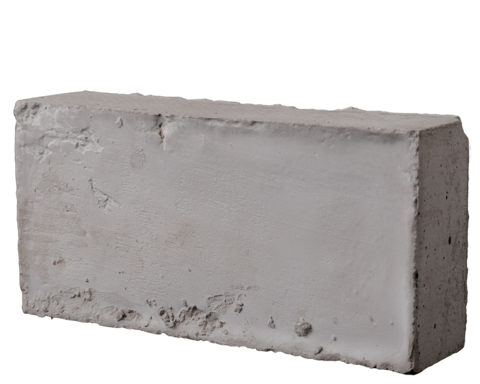Trass lime
Life Cycle Transition
About the Product

homemade sample: Gereon Berz, Nils Kleine Bornhorst
(Manufacturer: ZEMENT- UND KALKWERKE OTTERBEIN GMBH & CO. KG)
homemade sample with cork aggregate: Gereon Berz, Nils Kleine Bornhorst
(Manufacturer: ZEMENT- UND KALKWERKE OTTERBEIN GMBH & CO. KG)Trass lime (“natural cement”) is a mixture of hydraulic lime or slaked lime powder with ground trass powder. Trass is volcanic pozzolan, which, among other materials, consists mainly of reactive alumina (aluminium oxide) and silicic acid (silicon dioxide). Finely ground trass reacts with hydrated lime, for example, so that it sets hydraulically (cement-like). Trass is extracted in the Eifel region (Rhenish trass), for example. Compared to conventional cement, trass lime does not require the energy-intensive process of cement clinker burning and thus has a lower carbon footprint.
Mixed with water, it produces a mortar that can also be used outdoors and is often used in the renovation of older houses and in the preservation of historical monuments. In addition, it is used as edge reinforcement for clay stairs, as an erosion brake in rammed earth construction or, replacing conventional cement concrete, as a lintel over openings or as a ring anchor. In the case of greater demands on load-bearing capacity, reinforcing steel can also be inserted and rammed in this case to absorb the tensile forces.
Otterbein’s trass lime “FL B 2” can withstand a compressive load of 9.5 N/mm² after 12 months due to its post-hardening and thus has strength values similar to concrete. Trass lime is frost-resistant, open to diffusion, has a high storage capacity and a low-stress hardening process. Trass lime also has a lower tendency to efflorescence than concrete.
Due to the chemical process of setting, the recyclability of trass lime is limited, but separation by type is possible, even with inserted reinforcing steel. For this purpose, the trass lime is crushed and reused, for example, as bulk material or aggregate.
Manufacturer: ZEMENT- UND KALKWERKE OTTERBEIN GMBH & CO. KG